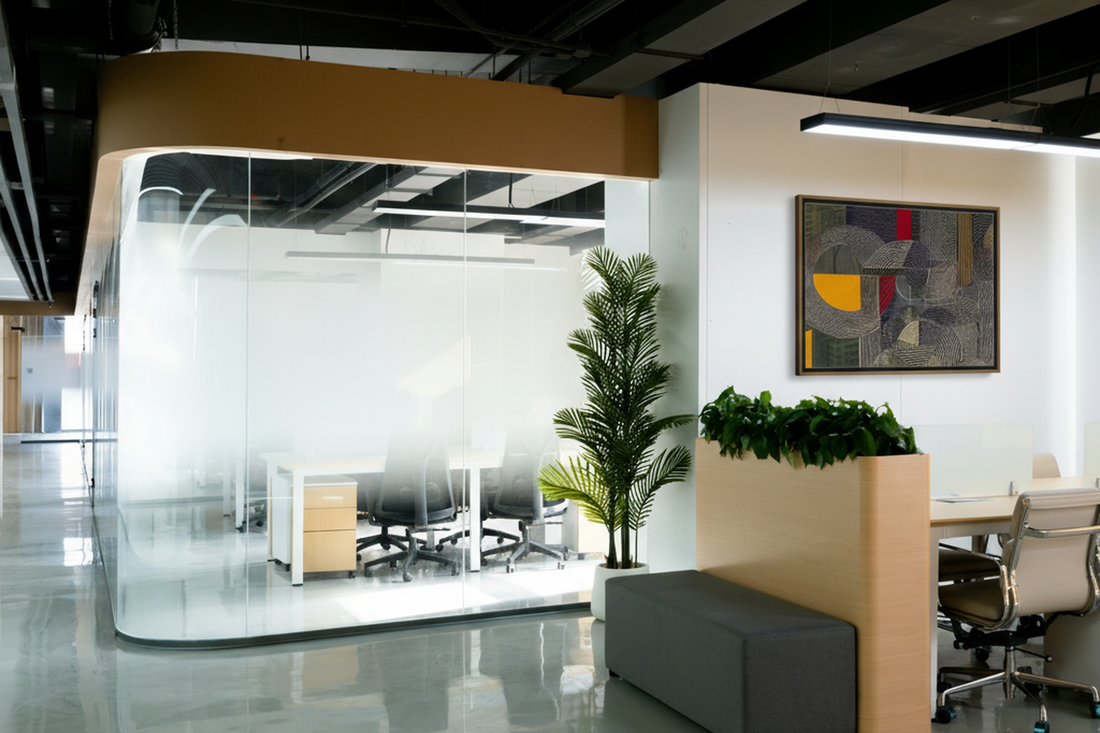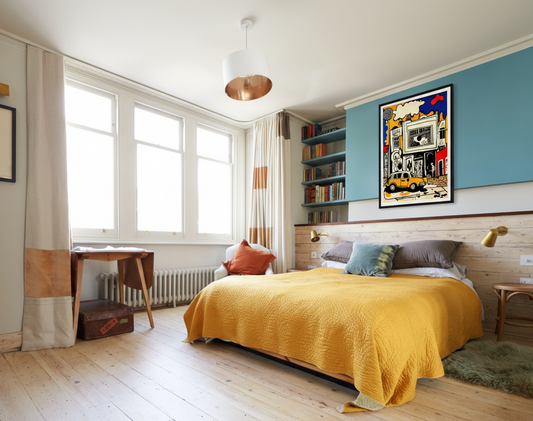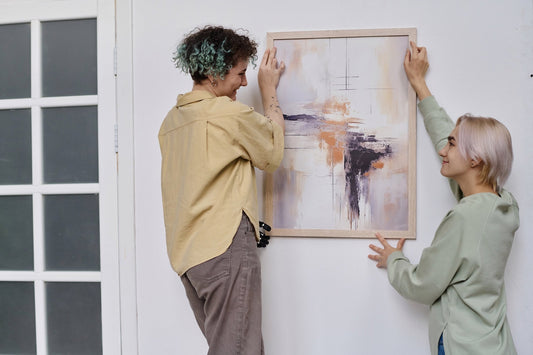
A Complete Guide to Styling Professional Offices With Wall Art
Did you know that you can influence what your clients feel before they even set foot in a meeting room with you?
Color lightness and darkness, hues, circular shapes, lines, segments, shades, height, width, length, and many others contribute to creating the atmosphere of a space.
For example, you can greet your associates, clients, and visitors with:
- a clean, well-lit, and well-designed space gives the feeling of safety
- a large potted plant to brighten the mood and lower stress levels
- a carefully chosen wall art that a client may ponder on during the 3 short minutes that they wait in the lounge.
Organization, brand culture, and inspiration are evident as one moves from the lobby, past the busy working floor, and towards your executive office.
Design elements, therefore, are a powerful tool to help mirror the professionalism you want to convey in the workplace. The psychological impact not only builds an initial impression of trust with a client but also boosts energy, happiness, and motivation with the people working there.
This is true for most corporate offices, and more so for esteemed places like law offices, accounting firms, and other executive offices that benefit from a thoughtfully designed space.
This guide will help you in the following ways:
- Overview: Benefits of wall art in the workspace
- Which themes or types of office artwork suit best
- How to match art with office type
- How to style every room in an office
- How to install and maintain office wall art
Benefits of Wall Art in the Workspace
Wall art for offices is as important as furniture and lighting. Here’s what happens when you transform dull corners and blank office walls:
Reduce Stress and Boost Your Mood
An art-filled office keeps employees motivated and productive at work. Displaying an abstract piece or a calming landscape helps set the right mood.
Individuals exposed to art in the workplace reported a 32% increase in their overall well-being.
Harvard Business Review suggests that the more engaged employees are, the more productive they become.

Why does this happen? Art can trigger our pleasure and reward centers in the brain. Natural elements, such as paintings, make people feel happier and less angry. In a study on employee mental health and work attitudes, getting exposed to nature helps individuals stay calm and positive at work. Even in clinics, patients feel relieved upon seeing art in corridors, exam rooms, and waiting areas.
Encourage collaboration
The office is a shared space. The goal is to make people feel welcome.
In an article about “Collaborative Art: A Transformational Force within Communities” by the University of Chicago Press Journals, art is described as a shared celebration that fosters a sense of belonging. Ultimately, it can encourage collaboration in the workplace.
Color psychology is a great tool for your branding. For instance, warm shades like orange and yellow convey optimism and confidence. Vibrant tones encourage workers to bring their creative ideas to life.
Just like color schemes, the size of the art matters. You can use medium-sized pieces as a focal point in small rooms. If you’d like to highlight a masterpiece, a large art print is the best option.
Try decorating your boardroom with wall art. You’ll be surprised at how your attendees become more receptive and expressive.
Enhance Company Culture
The first impression of your prospective clients all boils down to how the atmosphere of your office makes them feel at a glance. Does it overflow with color and personality? Perhaps they’ve seen art that demonstrates your company’s commitment, then you did a great job in choosing the right design for your office wall art.
Of course, there’s no need to flaunt just to impress. You don’t have to spend billions of dollars to style your office like Google’s New York headquarters. It’s always best to display art that reflects your company’s culture, no matter the budget.
Be relevant and meaningful. Start by highlighting your social responsibility programs in a way that resonates with your company's efforts to help communities. You can strategically display art with scenes and photographs of children, animals, or the environment.
Style your office with art that speaks professional.
Common Themes or Types of Office Artwork
Art has evolved into different styles. If you’re a fan of Mad Men and Don Draper’s home design, you’re leaning towards mid-century art. If you like the offices of Jessica Pearson, Louise Litt, or Harvey Spectre from Suits, you might be interested in modern abstract and geometric design.

A large, modern abstract wall art piece behind Harvey Specter in the Suits TV series, as seen on Suits' Official YouTube channel.
Here’s a glimpse into some of the prominent art styles that can serve as an inspiration for your office wall art.
Abstract
Dating back to the 19th century, abstract art inspired artists to create freely. They began experimenting with bold colors, shapes, forms, and subjects.
In 1910, Russian painter and Father of abstract art Wassily Kandinsky produced his first abstract watercolor. Other famous abstract artists include Hilma af Klint and Piet Mondrian.

Featured Artwork: Architectural Rhythms
Swedish artist Hilma af Klint focused on botanical art, while Dutch artist Piet Mondrian liked using squares, rectangles, and primary colors in his paintings, particularly of trees.
Here are the characteristics of abstract art:
- Bold colors
- Subjective and non-representational
- Freedom of form and interpretation
Abstract art is popular in high-end offices because of its sophisticated allure. It uses thought-provoking visuals and unrecognizable scenes that are open to interpretation.
Through varied elements, abstract wall art for offices perfectly captures the beauty of informal expression. The ambiguous power it holds helps stimulate creativity in the workplace.
Geometric
During the rapid industrialization, the geometric art movement inspired contemporary innovators in the early 20th century. They shifted from realism to optical illusions and symmetrical patterns.

Featured Artwork: Vibrant Metropolis
Geometric art pioneers like Kazimir Malevich, Piet Mondrian, and Theo van Doesburg favored dynamic compositions. Famous works include Malevich’s Black Square (1915), Composition in Red, Yellow, Blue, and Black (1921), and Van Doesburg's Counter-Composition V (1924).
The characteristics of geometric art include:
- Basic geometric forms (Suprematism)
- Harmony of lines and primary colors (De Stijl)
- Pure aesthetics (Minimalism)
Perfect for modern interiors, this art style adds a bold and dimensional effect to high-end offices. Its immersive look can engage and captivate your clients.z
Expressionist
Originating in the 20th century, expressionist art revolves around subjective emotions and spiritual themes. Many artists deviate from depicting reality. Instead, they chose to convey raw feelings as their form of creative expression.

Featured Artwork: Painted in Thought
Expressionist art founder Ernst Ludwig Kirchner, along with famous German artists Franz Marc, Gabriele Münter, and Marianne Werefkin, has gone beyond literal depictions of people and nature in their works.
Some notable characteristics of expressionist art include:
- Expressive brushstrokes (Fauvism)
- Russian folk art (Neoprimitivism)
- Nonsensical elements (Dadaism)
- Dreamlike imagery (Surrealism)
- Symbolic elements (Social Realism)
Artists prefer distorted subjects and exaggerated forms over realistic portraits. Their works explore the human psyche and subconscious mind. For executive offices, you can bring out your fun side through expressionist office wall art.
Mid-century
Following World War II, mid-century art flourished through the 1960s. Artists incorporate abstract geometric forms with minimalist aesthetics.
Popular mid-century modern artists such as Jackson Pollock, Mark Rothko, and Henri Matisse are known for their pop culture-inspired compositions.

Featured Artwork: City Geometry
The characteristics of mid-century art include:
- Simple yet functional
- Abstract and minimalist
- Contrasting colors
Later on, mid-century art had a significant impact on interior design and infrastructure. In fact, many mid-century graphic designers like Paul Rand came up with innovative corporate logos for IBM and ABC companies. Even famous TV shows like Mad Men and Suits depict mid-century flair.
For corporate offices and law firms, mid-century artwork helps anchor your space and add a timeless feel to it.
Impressionist
In the late 19th century, Claude Monet led the French art movement. Impressionists moved away from dreamlike landscapes and instead chose to depict scenes of everyday life.

Featured Artwork: Set Sail
Besides Monet, the most influential impressionists are Paul Cezanne, Camille Pissarro, Auguste Renoir, and Edgar Degas.
The characteristics of impressionist paintings include:
- Emphasis on light
- Smooth and visible strokes
- Vibrant effects
Despite the controversy surrounding Monet’s Impression, Sunrise (1872), the famous oil painting perfectly captured the sunlight and haze that awakens at dawn.
Meanwhile, Dutch Post-Impressionist painter Vincent Willem van Gogh became famous in Western art. His popular works, "The Starry Night" (1889) and "Sunflowers" (1888), are renowned for their vividness and lively brushwork.
Impressionist wall art channels an inviting atmosphere in the workplace. It’s the best choice if you want to bring the outdoors in.
Own a beautiful piece of abstract, geometric, or expressionist art in your executive office or boardroom.
Guide to Matching Art With Office Type
Art affects your productivity more than you think. It’s not just about the size and theme of the artwork that you must consider, but also the style that suits your office type.
To complement art with your workspace, choose the style that aligns with your industry and company culture.
Abstract Wall Art + Law Firm Office

Featured Artwork: Vibrant Symmetry
For law firms, consider timeless pieces that depict truth, fairness, and order. You can choose an abstract expressionist painting of the Greek goddess of law and justice, Themis.
Geometric Abstract Wall Art + Corporate Office

Featured Artwork: Urban Angles
For corporate offices, choose geometric abstract wall art that features sharp lines and symmetrical shapes. This helps accounting firms and financial institutions establish credibility and mathematical precision.
Geometric Abstract for Executive Office

Featured Artwork: Linear Landscapes
For executive offices, select pieces with bold colors and structured shapes to achieve a sophisticated look. A striking geometric abstract wall art is a good example to help maintain professionalism.
Expressionist Art for the Office

Featured Artwork: Solitude Towers
For design firms and advertising agencies, display vibrant paintings with exaggerated forms to spark conversations in spaces where innovation can thrive. Expressionist wall art helps boost creativity in brainstorming sessions.
Mid-Century Art for Office

Featured Artwork: Floating Perspective
For architectural firms, choose sleek pieces that are straightforward, versatile, and functional. A perfect example of this is mid-century art, such as classic geometric print or a minimalist sculpture, which appeals to clients looking to renovate their properties.
Impressionist Wall Art for Office

Featured Artwork: Evening Canal Reflections
Bring the outdoors in using landscape office wall art. Famous impressionist paintings like The Starry Night by Van Gogh convey a sense of movement in collaborative spaces.
How to Style Every Room in an Office
There are two types of office layouts, the traditional and open-plan. The traditional layout is commonly used in private offices, cubicles, and common areas. Meanwhile, open-space layouts don't have walled cubicles. Instead, it features a large, open space with flexible workstations, so employees can interact whenever.
When styling an office with artwork, choose remarkable pieces that draw the eye in. These can be vintage prints, landscape paintings, framed portraits, and abstract posters.
Let’s take a look at this example of a corporate office and our featured wall art for each room:
Lobby/Reception
In the reception area, you can hang landscape wall art prints to establish a welcoming atmosphere.

Featured Artwork: The Waiting Room
Meeting Rooms
For conference rooms, consider geometric art prints that can stimulate the mind.

Featured Artwork: Vortexes in Motion
Boardroom
As for the boardroom, you can choose mid-century wall art that can match the functional aesthetic of your space.

Featured Artwork: Urban Fragments
Working Floor
For your working floor, you can consider seascape art prints that bring a sense of calm into the room.

Featured Artwork: Golden Bridge Sunset
Pantry
For the pantry, incorporate wall art that depicts food to make the space more inviting.

Featured Artwork: Tangerine Tangle
Collaboration Spaces
As for your collaboration spaces, consider displaying people's wall art prints to boost productivity among your employees.

Featured Artwork: Inner Circuitry
Office Art Featured In This Blog
Did you see anything you liked from the blog? We've listed the products here so you can check them out:
How to Install and Maintain Office Wall Art
In many offices, the walls are often overlooked, which can convey a lack of personality. Without visual appeal, you can communicate the wrong message to your clients within seconds of meeting them.
The good news is that there are plenty of ways to style your office space with wall art. Using art strategically can effectively introduce your business, services, and even company culture to your clients.
Here’s how to install and maintain your office wall art:
-
Measure your wall to get the right art size
The ideal size of your artwork should occupy two-thirds of your wall and be at least 57 to 60 inches from the floor. This allows enough breathing room for your art to stand out.
-
Hang your prints at eye level
When mixing sizes, keep your artwork at least 2 to 3 inches apart. Eye-level anchoring helps maintain visual interest.
-
Keep away from direct sunlight and wipe carefully with a dry cloth
Don't place your artwork near bathrooms and kitchens to avoid the color/brushwork from fading. When cleaning your art prints, dust gently with a soft cloth.
Our Fine-Arts Inspired Office Wall Art Collection
Hive Artes is a digital shop designed for art lovers looking for murals that are exclusively made for them. Our passion for art has inspired us to style spaces with affordable, fine arts-inspired pieces.
Our goal is to transform your bare walls with chic and sophisticated wall art for office spaces. At Hive Artes, we offer museum-quality and ready-to-hang framed posters that are easy to install. If you’re not satisfied with your order, contact us within 30 days so we can return it or give your money back. Free shipping in the U.S.
Find art that you’ll love from thousands of designs from Hive Artes Collections.





















